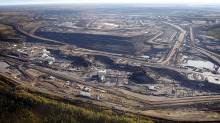Imperial to Spend $100-Million to test new oil sands Technology
 Imperial Oil Ltd. is spending $100-million to test out a new oil sands technology that promises to dramatically reduce greenhouse gas emissions, even as critics say industry has underestimated its vulnerability to financial and climate realities.
Imperial Oil Ltd. is spending $100-million to test out a new oil sands technology that promises to dramatically reduce greenhouse gas emissions, even as critics say industry has underestimated its vulnerability to financial and climate realities.Instead of heating water into a 300-degree steam and injecting it below-ground to melt out the bitumen, Imperial is experimenting with a technology that uses other substances, called solvents, to thin the heavy oil sands crude and make it flow.
Importantly, it doesn’t require heating up those solvents – industry often uses propane or butane as solvents – to free up the bitumen. The heating of water into steam at today’s oil sands operations burns vast quantities of natural gas, and is responsible for a substantial component of the greenhouse gas emissions at so-called “in situ” operations that use wells, rather than open-pit mines, to produce oil.
Imperial calls its new process a “non-thermal” operation, and workers are now drilling three wells to test how it works in the field.
“It works great in the laboratory,” Imperial chief executive officer Bruce March said. The process still uses some heat to separate out the solvents at surface. But it is “miniscule” relative to current in situ operations, called steam-assisted gravity drainage, he said.
If the non-thermal pilot project works, it stands to change the way industry brings to surface the 80 per cent of oil sands reserves accessible with in situ methods. “We’ll be able to reduce the overall greenhouse gas emissions intensity down very near to the level that conventional oils produce today,” Mr. March said at an energy roundtable in Calgary on Tuesday.
“Think of that what that could mean for the public perception of Canada’s oil sands.”
Imperial is also looking at using solvents in mining, with a “non-aqueous” process that promises to cut water use in oil sands mines by 90 per cent, and eliminate the gaping effluent lakes that now mar the landscape around Fort McMurray. That technology could be ready for commercial use in a decade, Mr. March said.
The Imperial advances come amid a broad industry push to better its operational performance in the oil sands. Companies face a “cost conundrum” as they pursue growth, said Jean-Michel Gires, chief executive of Total SA’s Canadian operations. The oil sands, he noted, are “probably one of the most expensive oils to develop in the world.” Total and partner Suncor Energy Inc. are undertaking a rigorous examination of costs at some of their planned growth projects.
Still, the oilpatch may not fully appreciate how those costs make it vulnerable, said David Keith, a Harvard professor and Alberta entrepreneur. In part, that’s because new supplies of oil, liberated by technological advances, mean oil may not be as scarce, or “tight,” as once believed. It doesn’t help that some of those new oil supplies can be tapped more cheaply than the oil sands.
“There’s been a kind of over-confidence about the fact that ‘we don’t need to worry that much about our costs here’ because everybody will eventually come to our door because oil is so tight,” Mr. Keith said. “I think it’s very unlikely that’s true.”
He also pointed to statistics showing a flattening in demand for vehicles – especially among younger people in North America – a trend that may dampen future oil needs.
“There really is a possibility that demand for fuels will flatten more than people will think,” he said.
And, he added, advances like the new Imperial technologies are set against a backdrop of worsening, rather than improving, emissions performance in the oil sands. Innovation gains are coming at a time when companies are accessing less desirable parts of the oil sands that are less efficient to produce, he said. Evidence already suggests, he said, that the greenhouse gas output from in situ operations is increasing.
In the oil sands, “the carbon life cycle is pretty high … and it’s not clear to me it’s going to get better,” Mr. Keith said.
He added: “It’s important to face reality.”
You can return to the main Market News page, or press the Back button on your browser.

